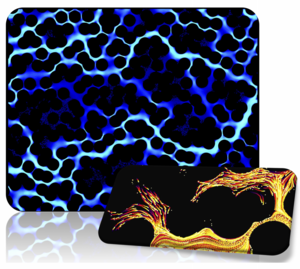- Phoretic Transport of Colloids, Emulsions, and Macromolecules in Complex Environments:

Our research delves into the fascinating field of transport in porous media and complex environments, addressing challenges in geosciences, human health, and technological applications.
One crucial area of our investigations lies in understanding how colloids, emulsions, and macromolecules navigate through heterogeneous environments in the presence of spatiotemporal fluctuations in flow fields and chemical gradients. These are common scenarios encountered in many applications ranging from agriculture and water remediation to drug delivery, separation and purification processes, chemical sensing and detection, and even cargo transport within living cells.

Our goal is to predict and control the transport and dispersion of colloids, emulsions, and macromolecules in these dynamic environments, revisiting the classical description of transport in complex media, in which geometric features of the media alone determine the transport. Our work sheds light on how externally-imposed or internally-generated chemical gradients lead to significant deviations from this classical description, pointing to the need for a new framework for modeling and predicting transport in crowded environments.
- Bacterial Chemotaxis and Collective Behavior in Dynamic and Crowded Environments
Bacteria navigate their environments, following chemical gradients, searching for nutrients and new territories. While our understanding of bacterial chemotaxis in the presence of steady gradients has dramatically improved over the past few decades, much less is known about how transient chemical gradients and flows, which are ubiquitous in bacterial natural habitats, from rhizosphere (bacteria-plant roots ecosystem in soil) to phycosphere (phytoplankton-bacteria ecosystem in the oceans), and to human gut, where bacteria can be both beneficial or pathogenic. These are important problems with implications for vital processes such as nutrient cycling, agriculture, carbon cycle, and human health. Our goal is therefore to revisit bacterial chemotaxis and collective behavior in dynamic environments in the presence of spatiotemporal fluctuations in the nutrient field and flows.




- Biofilm Formation in Disordered and Chemically-Heterogeneous Environments
Our investigations extend to the study of biofilm formation, growth, and dispersion. Biofilms are complex communities of microorganisms that adhere to surfaces and thrive in diverse environments. Understanding the transport mechanisms within biofilms is crucial, as it influences their development, structural stability, and overall behavior. By unraveling the intricacies of biofilm dynamics, we gain valuable knowledge that has applications in various areas such as in chronic infections, where biofilms protect bacteria from antimicrobial treatments and the immune system. We aim to develop targeted strategies to control biofilm formation and growth and enhance the efficacy of antimicrobial therapies.

- Interfacial Instabilities in Confined and Disordered Media: Interfacial flows are ubiquitous in nature and technological applications, from dripping faucets to the storage of CO2 underground. To control these flows and predict their outcome, we need to understand how fluid-fluid interfaces behave and deform, in particular when they are confined in narrow spaces. In confinement, the interactions between the fluids and the surrounding solid surfaces become important. While these interactions are typically nanometric in range, they can influence the dynamics on much larger length scales.

- Phase Change and Phase Separation in Multicomponent Mixtures and Colloidal Dispersions:

The dynamics of evaporation and condensation in pure liquid drops and thin films is relatively well understood. However, most liquids used in technological applications are a mixture of multiple components. These components often have different properties and might even phase separate under certain conditions, leading to significant departure from the behavior observed in pure liquids.



To find out more, check the publications page.